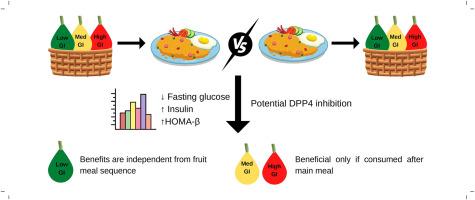2 型糖尿病患者低、中、高血糖指数水果餐顺序随机对照试验
Q3 Nursing
引用次数: 0
摘要
目的我们旨在通过测量空腹血糖(FBG)和胰岛素水平、β细胞功能的稳态模型评估(HOMA-β)和二肽基肽酶-4(DPP4)活性,研究印度尼西亚T2DM患者水果餐序的低、中、高血糖生成指数。方法2018年11月至2019年3月进行了一项随机对照试验(RCT),共纳入48名参与者。餐序处理分两个时间段进行:1-7 天水果最后一餐(FL)和 14-21 天水果第一餐(FF)。结果在两个时间段内,对照组和低 GI 之间的胰岛素和 HOMA-β 均有显著差异。结论我们的研究清楚地发现,食用低 GI 水果有利于提高胰岛素水平和 HOMA-β,但与水果进餐顺序无关。中等 GI 和高 GI 水果只有在主餐后食用才对胰岛素水平和 HOMA-β 有益。虽然在 7 天和 21 天后观察到 FBG 水平明显下降,但对间隔期(第 7-1 天和 21-14 天)的分析表明,在餐后或餐前食用水果后,FBG 水平没有变化。本研究提供了水果餐顺序如何直接影响 FBG 水平、胰岛素水平和 HOMA-β 的证据。鉴于水果进餐顺序的重要影响,本研究为在 T2DM 管理中整合优化水果纤维摄入和进餐顺序提供了启示。本文章由计算机程序翻译,如有差异,请以英文原文为准。

A randomized controlled trial of fruit meal sequence with low, moderate, and high glycemic indexes among type 2 diabetes mellitus patients
Aim
We aimed to study the low, moderate, and high glycemic indexes of fruit meal sequence among T2DM patients in Indonesia by measuring Fasting Blood Glucose (FBG) and insulin levels, Homeostasis model assessment of β-cell function (HOMA-β), and Dipeptidyl peptidase-4 (DPP4) activity.
Methods
A randomized controlled trial (RCT), which included 48 participants, was conducted from November 2018 to March 2019. The meal sequence treatments were done in two intervals: 1–7 days fruit last meal (FL) and 14–21 days fruit first meal (FF).
Results
Significant differences in insulin and HOMA-β between control and low GI were observed in both intervals. However, no significant changes in Insulin level (5.16±3.47 vs. 5.51±6.16 μIU/ml, p=0.819) and HOMA-β (17.61±11.33 vs. 20.65±17.88, p=0.465) were observed from low GI in two different intervals.
Conclusions
Our study clearly uncovered that low GI fruit consumption is beneficial in increasing insulin levels and HOMA-β but is independent of fruit meal sequence. Moderate and high GI fruits showed beneficial effects on insulin levels and HOMA-β only if consumed after the main meal. Although a significant decrease in FBG levels after 7 and 21 days was observed, the analysis on intervals (day 7-1 and 21-14) showed no changes in FBG levels after fruit sequence after or before meal. Further studies are needed to investigate the long-term effects of fruit meal sequence on glycemic parameters.
This study provides evidence on how fruit meal sequence can directly affect the FBG level, insulin level, and HOMA-β. Given the essential effects of fruit meal sequence, this study gives insight into the integration of optimization of fiber intake from fruits and the meal sequence in T2DM management.
求助全文
通过发布文献求助,成功后即可免费获取论文全文。
去求助
来源期刊

Clinical Nutrition Open Science
Nursing-Nutrition and Dietetics
CiteScore
2.20
自引率
0.00%
发文量
55
审稿时长
18 weeks
 求助内容:
求助内容: 应助结果提醒方式:
应助结果提醒方式:


